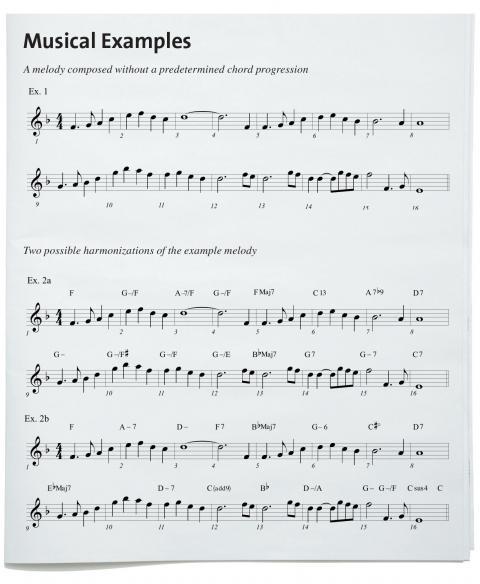The Woodshed: Composing Independent Melodies
Mark Simos is an associate professor in Berklee’s Songwriting Department. This lesson is an edited excerpt from his new book Songwriting Strategies: A 360° Approach, published by Berklee Press. Visit Simos online at songwritingstrategies.com and 360songwriting.com. Phil Farnsworth
A songwriter should be able to write different kinds of melodies: melodies locked tightly to harmony, or floating independently of harmony, or falling anywhere along the spectrum of possible melody/harmony textures. Rather than thinking in terms of a single creative operation—“setting from a melody to harmony”—think of transforming a melody along the melody/harmony continuum. We want similar freedom in our chord progressions, whether we write them in response to melodies or as a springboard for melodies to come.
In theory, you can start from a song “seed” in any facet (rhythm, lyric, melody, or harmony) and set it to material in any facet. But a repertoire of different strategies helps only if applying them gets you to different results. Achieving true independence of melody and harmony is not so easy, even when apparently working with each element in isolation. To put this to the test, try to create an a cappella melody. You’ll likely still hear an implied harmony—your melody was generated in association with imagined chords. Try to write multiple chordal settings for the melody. As you put different sets of chords to melody, the expected “already heard” chords will sound right; significantly different choices may not.
Independent, distinct, and memorable
In his seminal book Melody in Songwriting, Jack Perricone introduced the notion of independent melody in the context of songwriting, as a melody sufficiently well formed to be interesting, engaging, and memorable without harmonic accompaniment. Contrast a piece like “One Note Samba” with “Somewhere Over the Rainbow.” In the former, melodic interest is created through interaction with the harmony. The latter tune stands on its own with intrinsic melodic interest. Unlike many chord-driven melodies (built primarily of scalar steps or skips forming arpeggiated chords, with anchor tones that are mostly chord tones), the contour of “Somewhere Over the Rainbow” with its varied leaps and scalar passages is memorable, expressive, inherently evocative—echoing the narrative theme, imagery, and character of the song. Thus, this melody is independent in that it is distinct and memorable. It doesn’t require the presence of chords to be effective, and can be sung beautifully a cappella. (I’m not claiming it’s superior to “One Note Samba”; it’s a different type of tune. “One Note Samba” uses its chanting-tone melody just as artfully.)
Example 1 shows a melody in a “Somewhere Over the Rainbow” vein—though not nearly as good. Like its immortal precursor, it has an octave leap—but at the end of the phrase, and down instead of up (see bar 15). It was written without an explicit, pre-determined chord progression in mind.
This melody moves relatively freely in range and intervallic variety, showing continuity and unity. It covers a good range for vocal melody: an octave plus diminished fifth, from its lowest note (E in bar 16), the leading tone below the tonic, to the highest note (Bb in bar 10), a fourth above the octave of the tonic. It mixes steps and leaps, avoiding extended passages that are purely scalar or arpeggiated. The phrases cadence on structural tones that take on meaning and create contrast in terms of stable versus unstable relationships to F, the tonal center. The melody uses several motivic devices, including repetition, sequence, and extension with inversion. It has an arc, a narrative, and stands on its own to tell a story.
Partly as a result of these attributes, this melody could be harmonized in various ways. Two possibilities are shown in examples 2a and 2b.
As these alternate harmonizations demonstrate, different harmonic settings can shift chord-tone/nonchord-tone relationships of given notes (e.g., the C chord against the D note in bar 12 of ex. 2b). We can range from what a more restrained jazz accompanist might do, toward more extensive reharmonization—even shifting tonic, subdominant, or dominant harmonic functions on key notes (as seen in the respective fifth bars of the two versions). Because of this freedom, progressions can follow their own voice-leading or bass-line logic, as in the line cliché seen in bars 9-12 of example 2a, or the more unexpected descending bass line in bars 9-15 of example 2b.
This harmonic flexibility can be used in developing or revising the song, or structurally by varying the harmonizations of different repetitions of a melodic figure or phrase within or across sections of the song.
Independent Tonal Melody

However, a key to this flexibility is that both melodies and harmony are ultimately firmly rooted in the feel of major/minor tonality.
This is evident from certain aspects of our example melody. The key is unambiguously suggested by the leading tone resolving back to the tonic (see bars 2 and 14-15), and by the melodic movement spanning a tritone from E to Bbin bar 6.
The melody’s motivic construction is also typical of techniques used for tonal melody. By relying heavily on sequences, especially at the interval of the second—both consecutively (see bars 10-11) and at matched points in phrases, (see bars 2 and 6, and in bars 1 and 9)—the melody combines figural integrity with effects of re-coloring chord-tone/non-chord-tone relations of constituent notes to the tonal center.
I believe such techniques lie at the heart of the elegance and sophistication of the Great American Songbook and related styles. While these vocal melodies characteristically move differently from vocal lines developed for early polyphonic music, it could be argued that the melody/harmony relationships of this classic era of song repertoire express deep contrapuntal principles.
Certainly, they represent one stylistic apotheosis of the techniques for achieving independence of vocal melody with underlying harmony. These techniques allow creation of melodies with intrinsic interest in melodic contour, well suited to expressive styles that emphasize range and other aspects of vocal performance. Generations of interpreters, arrangers, and improvisers who have used this repertoire as a foundation have built their art on these inner principles of construction in the songs themselves.
For contemporary songwriters, these techniques also extend process flexibility, allowing us to work either melody first or chords first while still achieving a measure of independence in the resulting texture.
Even working melody first, Great American Songbook writers were intuitively grounded in the language of tonal harmony. Yet there is a vast territory of melodic music not driven by functional harmony—including modal music of many cultures and eras, and surprisingly, much contemporary popular music as well. We can broaden our strategies for composing independent melodies beyond tonally derived melodies by exploring these possibilities, potentially comparable in expressiveness to the elegant melodic and harmonic relationships in the tonal vocabulary of the Great American Songbook. Call it the Great Global Songbook—still to be written.




